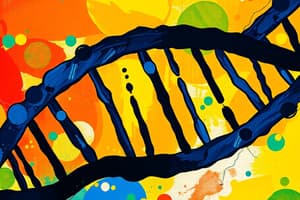Podcast
Questions and Answers
What is the main objective of isolating genomic DNA?
What is the main objective of isolating genomic DNA?
- To identify the sequence of DNA.
- To create copies of DNA.
- To study the structure of DNA.
- To obtain high molecular weight DNA purified from proteins and enzyme inhibitors. (correct)
Which of the following is NOT a common source of human DNA for molecular studies?
Which of the following is NOT a common source of human DNA for molecular studies?
- Bone marrow (correct)
- Epithelial cells
- Peripheral blood
- Hair follicles
What is the purpose of EDTA in blood collection tubes for DNA isolation?
What is the purpose of EDTA in blood collection tubes for DNA isolation?
- To prevent blood clotting and inhibit the activity of deoxyribonucleases. (correct)
- To activate enzymes responsible for DNA replication.
- To preserve the integrity of red blood cells.
- To enhance blood clotting and promote DNA degradation.
What is the primary consideration in choosing a DNA isolation method?
What is the primary consideration in choosing a DNA isolation method?
Which of the following is NOT a potential application of isolated genomic DNA?
Which of the following is NOT a potential application of isolated genomic DNA?
Which of the following methods is NOT a method for purifying DNA?
Which of the following methods is NOT a method for purifying DNA?
What is the purpose of using chaotropic salts in DNA isolation by the column method?
What is the purpose of using chaotropic salts in DNA isolation by the column method?
Which of the following reagents is commonly used for DNA precipitation in organic methods?
Which of the following reagents is commonly used for DNA precipitation in organic methods?
In the salt method of DNA isolation, what is the purpose of adding NaCl?
In the salt method of DNA isolation, what is the purpose of adding NaCl?
Which of the following is NOT a common contaminant found in DNA and RNA preparations?
Which of the following is NOT a common contaminant found in DNA and RNA preparations?
What is the purpose of the washing step in the column method of DNA isolation?
What is the purpose of the washing step in the column method of DNA isolation?
Which of the following techniques is NOT used to determine the purity and concentration of DNA?
Which of the following techniques is NOT used to determine the purity and concentration of DNA?
Why is it important to pre-dilute DNA samples before spectrophotometric measurement?
Why is it important to pre-dilute DNA samples before spectrophotometric measurement?
Which of the following techniques can be used to homogenize soft animal tissues?
Which of the following techniques can be used to homogenize soft animal tissues?
What is the primary purpose of protein lysis (denaturation) during DNA isolation?
What is the primary purpose of protein lysis (denaturation) during DNA isolation?
Which of these methods is a common technique for isolating DNA from bacterial cells and cell cultures?
Which of these methods is a common technique for isolating DNA from bacterial cells and cell cultures?
Which of the following is NOT a commonly used material for diagnostic studies?
Which of the following is NOT a commonly used material for diagnostic studies?
What is the ideal storage condition for biological material that cannot undergo DNA isolation within 48 hours?
What is the ideal storage condition for biological material that cannot undergo DNA isolation within 48 hours?
How might a sample be protected during transportation?
How might a sample be protected during transportation?
What is a crucial step to ensure proper DNA isolation?
What is a crucial step to ensure proper DNA isolation?
Why is it essential to inactivate nucleases during the DNA isolation process?
Why is it essential to inactivate nucleases during the DNA isolation process?
Flashcards
Purpose of DNA Isolation
Purpose of DNA Isolation
To obtain high molecular weight DNA purified from proteins and inhibitors.
DNA Isolation Method Factors
DNA Isolation Method Factors
Choice depends on nucleic acid type, origin, material, results, and purpose.
Common DNA Source in Humans
Common DNA Source in Humans
Peripheral blood is the most common material for DNA isolation.
EDTA in Blood Collection
EDTA in Blood Collection
Signup and view all the flashcards
Other DNA Sources
Other DNA Sources
Signup and view all the flashcards
DNA isolation
DNA isolation
Signup and view all the flashcards
Chromatographic methods
Chromatographic methods
Signup and view all the flashcards
Phenol method
Phenol method
Signup and view all the flashcards
Salt method
Salt method
Signup and view all the flashcards
Proteinase K
Proteinase K
Signup and view all the flashcards
Spectrophotometric measurement
Spectrophotometric measurement
Signup and view all the flashcards
Agarose gel electrophoresis
Agarose gel electrophoresis
Signup and view all the flashcards
Contaminants in DNA solutions
Contaminants in DNA solutions
Signup and view all the flashcards
Stages of DNA isolation
Stages of DNA isolation
Signup and view all the flashcards
Transport of samples
Transport of samples
Signup and view all the flashcards
Homogenization
Homogenization
Signup and view all the flashcards
Cell lysis
Cell lysis
Signup and view all the flashcards
Enzymatic lysis
Enzymatic lysis
Signup and view all the flashcards
Chemical lysis
Chemical lysis
Signup and view all the flashcards
Storage conditions
Storage conditions
Signup and view all the flashcards
Solvent-based DNA isolation
Solvent-based DNA isolation
Signup and view all the flashcards
Study Notes
Isolation of Genomic DNA
- The goal is to isolate high-molecular-weight DNA, free of proteins and enzyme inhibitors.
- This purified DNA is crucial for subsequent DNA-related work.
- Applications include genetic disease detection, cancer predisposition assessment, next-generation drug production, cell therapy, and genetic engineering.
DNA Structure
- DNA is a double helix.
- The double helix is composed of a sugar-phosphate backbone.
- Nucleotides, containing bases (adenine, thymine, cytosine, and guanine), form the "rungs" of the ladder.
- Hydrogen bonds connect paired bases (A with T, and C with G).
Choosing a DNA Isolation Method
- The best method depends on the type of nucleic acid needed (genomic, mitochondrial, plasmid).
- The source material's origin (plant, animal, bacterial, viral).
- The material type (tissues, organs, cell cultures).
- The expected results (purity, quality, time).
- The intended purpose (PCR, cloning, etc.).
Materials for Isolation (Human)
- Peripheral blood is a common source, isolated using EDTA tubes.
- EDTA prevents blood clotting and inhibits deoxyribonucleases (DNases).
- Heparin-containing tubes can negatively impact subsequent stages.
- Other sources include epithelial cells, fibroblast cultures, amniotic fluid cells (AFC), chorionic villus sampling (CVS), and hair follicles.
- Less common materials include blood spots, semen, tissue fragments, and bone marrow.
Stages of DNA Isolation
- Collection of the biological material sample.
- Transport of the collected material.
- Homogenization of the collected material.
- Protein lysis (denaturation).
- Purification of DNA from lysate remnants.
- Dissolving DNA.
- Qualitative and quantitative evaluation of the isolated DNA.
Transport
- Proper labeling is essential.
- Secure sealing of tubes or containers is necessary.
- Protection from damage and contamination is crucial.
- Protection from temperature changes during transport is needed.
Storage
- Immediately begin DNA isolation after sample collection.
- Tissues can be stored at 4°C for several days without significant DNA degradation.
- If isolation isn't possible within 48 hours of collection, freeze at -20°C or -80°C.
- Longer storage reduces both yield and DNA quality.
Homogenization
- The method depends on material origin.
- Soft animal tissues: homogenization.
- Cell suspensions and biological fluids: sonication (ultrasound) or chemical lysis.
- Plant cells: mechanical grinding.
- Bacterial cells and cell cultures: chemical lysis.
Cell Lysis
- Disrupts cell membranes to release DNA/RNA.
- Denatures proteins and inactivates nucleases.
- Methods: Enzymatic (proteinase K, collagenase, trypsin, chitinase), Chemical (chaotropic salts like guanidine isothiocyanate, detergents like CTAB, SDS, Triton X-100), Physical (heating, freezing, osmotic shock), and Mechanical (glass beads, aluminum oxides).
DNA Isolation Methods
- Solvent-based: Phenol-chloroform extraction, protein precipitation.
- Chromatographic: Binding DNA to carrier material (silica columns), magnetic separation.
Purification of DNA (organic method)
- Centrifugation to separate DNA from associated compounds.
- Use of a saturated phenol solution buffer, chloroform with isoamyl alcohol, mixture of phenol with chloroform and isoamyl alcohol (25:24:1).
Purification of DNA (salt method)
- Lysis, followed by centrifugation after adding sodium chloride.
- Precipitation process.
DNA Isolation by Column Method
- DNA binds to ion-exchange membranes, removing contaminants.
- The column is washed to remove impurities.
- DNA is eluted (removed from the membrane) using a low-salt buffer.
DNA Isolation by Magnetic Method
- DNA binds to paramagnetic beads.
- Removal of contaminants using washing steps.
- DNA is eluted into solution.
Quantification and Quality Assessment
- Crucial step for genetic material work.
- Contaminants (phenol, EDTA, heparin) can negatively impact analytical techniques (especially PCR).
- Methods for measuring DNA concentration: spectrophotometry, agarose gel electrophoresis.
Spectrophotometric Measurement
- Dilute DNA/RNA samples with water or TE buffer.
- Measure absorbance at specific wavelengths:
- 260 nm (DNA/RNA absorb strongly).
- 280 nm (proteins absorb).
- Ratio of absorbance at 260nm/280nm (A260/A280) indicates purity, typical ratios are:
- dsDNA ~1.8.
- RNA ~2.0.
- Values below 1.8 suggest protein contamination, 1.5 ≈ 50% contamination.
Studying That Suits You
Use AI to generate personalized quizzes and flashcards to suit your learning preferences.




